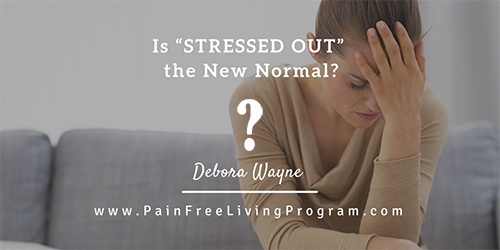Working with my clients from all over the world, it’s clear that an unreasonably high level of stress is becoming our “new normal.” My personal observations are validated by ample research that shows how saturated and over-the-top with stress our lives have become. Job pressure, money, health, relationships, poor nutrition, media overload, and sleep deprivation are the top causes of stress in the U.S.
According to a recent survey by the American Psychological Association (APA):
- Two-thirds of Americans said they were likely to seek help for stress.
- 54% said they are concerned about the level of stress in their everyday lives.
- 73% of Americans name money as the number-one stress factor.
- 62% of Americans say work has a significant impact on stress level.
- 54% of workers expressed concern about health problems caused by stress.
After working with thousands of people, and from my own personal experience as well, I’m quite aware of the problematic symptoms of stress, which include everything from severe fatigue, migraine headaches, upset stomach and digestion issues, muscle tension, pain symptoms, appetite changes, weight gain, emotional eating, insomnia, changes in sex drive, dizziness, brain fog, trouble concentrating, impaired memory, irritability, anger, nervous anxiety, teeth grinding, and more.
Why does this happen?
When an event occurs that you perceive as stressful, your body has an immediate physical response. A natural “red alert” goes off in your system. If the stressor continues, you may find yourself habitually adapting to this new level of stress, and if this pattern goes on for too long, it can eventually lead to exhaustion. This Red Alert–Adaption–Exhaustion stress pattern can ultimately lead to chronic pain, chronic fatigue, and/or illness.
The problems don’t end there. When stress persists for a long time and becomes chronic — it’s typical to also find depression and/or anxiety as well.
According to The World Health Organization statistics, an estimated 121 million people worldwide currently suffer from depression.
The National Institute of Mental Health findings show that depression often co-occurs with anxiety disorders and substance abuse.
Generalized Anxiety Disorder affects 6.8 million adults.
The body is completely interconnected with the mind and emotions. That’s why dealing with a health problem on only a physical level does not always solve the problem.
So what’s the solution?
When working with my clients — most of whom suffer from severe stress symptoms, depression and anxiety, panic attacks, chronic fatigue and chronic pain symptoms — I’ve found that using non-invasive methods for healing the mind and emotions often eliminates the physical stress and pain symptoms as well.
Here are some simple and practical tips to break free of stress patterns and live a more pain-free life:
-
Take the pressure off.
Slow Down. Wayyyy down. At the most stressful times, when there is already too much on your plate, rather than push and force….back off, take a long deep breath…prioritize. Trying to constantly do more, and do it faster, is not a healthy response. -
Learn to say no.
Ask yourself: What really must get done?
Learning to say No is often the real key to turning stress around. If you’re constantly worried about what other people think, about making people angry, or about trying to be nice all the time, it can lead to your own unhealthy stress levels. -
Re-frame stressful situations.
You have more power than you think to affect the stress response in your body and mind — for better or for worse. While you can’t control the stressful circumstances themselves — whether it’s a toxic boss or bad weather — you can definitely control how you interpret and respond to such factors. Work on trying to see the big picture of a situation, not just what’s bugging you about it in that moment. -
Take time to breathe.
One of the easiest things you can do to combat stress also happens to be among the most effective: focusing on your breath. Whether or not you try a formal meditation program, (check out “Meditation Made Easy” Here) you have the power any time to simply unplug from the problem, turn off your electronic devices, and do some deep breathing.
The bottom like is that stress IS dis-ease. So the next time you’re feeling tense, or you’re holding your breath because you feel so anxious, just stop. Stop everything and ask yourself: What is my top priority right now? How can I think about this situation differently? What can I let go of?
Give yourself permission to say no, or later, or never…and watch (and feel) what happens.
Want more practical tips on HOW to let go of stress, pain, anxiety,depression, and more?
DOWNLOAD THIS COMPLIMENTARY GIFT
Originally published at painfreelivingprogram.com on December 8, 2016.
Originally published at medium.com



